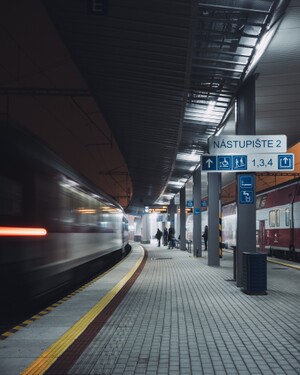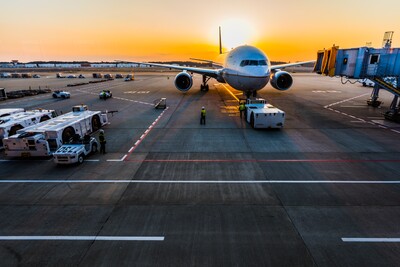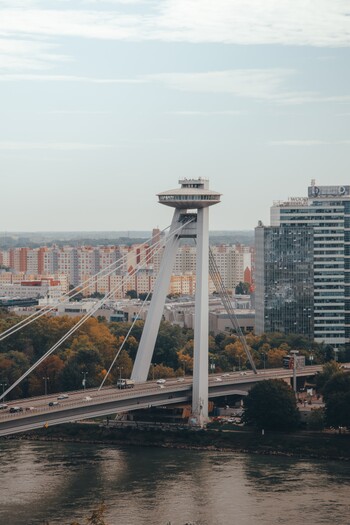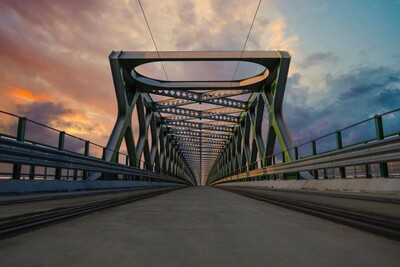 Photo: Shutterstock / Leonid Andronov
Photo: Shutterstock / Leonid Andronov
Transport
Travel by Train
Trains in the Slovak Republic are a safe and agreeable way to travel. There are 10 different types of trains:
| RJX | Railjet Express |
| IC | InterCity |
| SC | SuperCity |
| EC | EuroCity |
| EN | EuroNight |
| Ex | Express train |
| R | Fast train (in Slovak: “rýchlik”) |
| RR | Regional fast train ( in Slovak: “regionálny rýchlik”) |
| REX | Regional express train ( in Slovak: “regionálny expres”) |
| Os | Passenger train ( in Slovak: “osobný vlak”) |
 How to Find a Connection and Buy a Ticket
How to Find a Connection and Buy a Ticket
SLOVAK RAIL
The websites of the Slovak Railways ( https://www.zssk.sk/en/ ) provides information about time schedules, prices, duration of the journey and whether you have to switch the trains at any point.
Tickets can be bought, of course, also at the train station ticket offices or at some train stations in ticket machines. If applicable, the employee may ask you what type of train you would prefer. To guarantee a seat, it is possible to buy a seat reservation ( in Slovak: “miestenka”), since the trains may be crowded, especially on Fridays and Sundays when students travel to and from schools. International trains run several times a day from several train stations in the country. In most of them, a seat reservation is mandatory.
For most trains it is also possible to buy a ticket online at the Slovak Railways website.
ONLINE ITINERARY SERVICE
Online itinerary service website ( https://cp.hnonline.sk/en/vlakbusmhd/spojenie/ ) provides a complex travel itinerary planner. You can search according to the means of public transport (bus, train, municipal public transport), and also search for optimal combination of them to find the shortest route.
REGIOJET
Regiojet is a private railroad and bus transport provider in Slovakia and offers services of higher quality for reasonable prices. To find a connection or buy a ticket visit Regiojet website.
Zero-fare Public Rail Transport Services in Slovakia
Full-time students under 26 years of age with EU/EEA/Switzerland citizenship or residence are entitled to zero‑fare public rail transport services. Eligible passengers are required to register at the Slovak Railways ticket desks or via the internet. Upon registration, they will obtain their rail customer cards that will allow them to travel for free.
Students from the countries outside the EU/EEA/Switzerland can also get a zero‑fare ticket once they have submitted a confirmation of enrolment for the current academic year at an HEI institution in Slovakia together with an official translation to Slovak language and their ID card or passport.
Zero-fare tickets are passenger specific and apply to the trains of all categories operated by the Slovak Railways (apart from InterCity and private trains, e.g. Regiojet). Eligible passengers are required to secure one zero-fare ticket for each journey. For EuroCity/InterCity trains transit there is surcharge of 1 € for a seat reservation. When travelling outside Slovakia, the zero-fare transport is available only to the last train station in the territory of the Slovak Republic before crossing the border.
Detailed information about zero fare travel is available here.
 Travel by Coach
Travel by Coach
While the trains are more comfortable, coaches are sometimes more direct; they connect most of the towns and villages in Slovakia and are reliable and satisfactory. The first thing is to check out the already mentioned online itinerary service website, where you can find useful information on time schedule, duration of the route, prices, stops, etc.
For international bus travel you can buy tickets at the ticket office or travel agency. Eurolines is one of the biggest providers operating international lines together with its domestic branch Slovak Lines.
For international lines operated by Eurolines it is possible to buy/book a ticket online at their website.
You can also hop on a Flixbus connection in Slovakia, a transport company operating lines to over 2,500 travel destinations in 34 countries internationally within whole Europe.
Student Agency also provides several international and domestic lines with special prices for students (tickets can be bought online).
How to Buy a Ticket
Generally, when travelling by coach within Slovakia, tickets can be bought upon boarding. It is possible to buy a ticket with a seat reservation (in Slovak: “miestenka”) for long‑distance coaches at the ticket office of any bus station or in some cases online.
 Travel by Plane
Travel by Plane
There are 3 international airports in Slovakia – in Bratislava (“M. R. Štefánik International Airport”), in Košice (“Košice International Airport”) and in Poprad (“Poprad – Tatry International Airport”).
Vienna airport in Austria, Budapest airport in Hungary or Katowice airport in Poland are another international airports in neighbouring countries that are widely used by Slovaks as well as foreigners when arriving to Slovakia or travelling abroad from our country, as they are located very close and have great travel infrastructure with Slovakia.
Transportation between International Airports and Principal Slovak Towns
Bratislava International Airport
M. R. Štefánik International Airport is located 15 km from the Bratislava Old Town. A taxi into the town costs about €10 – 15 , depending on where in the centre you want to go. By bus, take the line No. 61 to “Hlavná železničná stanica” (Main Railway Station).
Košice International Airport
Košice International Airport is located 8 km from the Košice Old Town. The official airport taxi into the town costs from €10 , depending on where in the centre you want to go. There is also a public bus line between the airport and the city No. 23, connecting the airport with the main railway station and bus station (“Staničné námestie”).
Vienna International Airport (Austria)
Thanks to the short distance between Vienna and Bratislava (60 kilometres) it is also possible to use the Schwechat International Airport in Vienna , which is larger than the M. R. Štefánik International Airport in Bratislava and then take a bus or a taxi to Bratislava. Just in front of the arrival gate at Vienna airport, you will find the platform for departure of buses leaving to Bratislava, where you can change to bus/train to other Slovak principal towns, e.g. Košice, Banská Bystrica, Trnava, Žilina, Trenčín, Piešťany, etc. Most of the buses terminate at the Main Bus Station in Bratislava (“Hlavná autobusová stanica”) called “Mlynské Nivy”.
A one‑way ticket from the Vienna Airport to the Bratislava Central Bus Station costs from €5 € to €7 , plus charging from €0.50 to €1 per piece of luggage. For the bus schedule browse Regiojet, Slovak Lines or Flixbus.
TIP: If you manage to buy your ticket online early, you can even get your one‑way travel ticket for €1 by Slovak Lines.
 Local Transport
Local Transport
Municipal public transport system is quite reliable. A network of public transport – usually buses and trolleybuses (also a network of trams in Bratislava and Košice) cover most of the towns. Operating hours are typically from 5:00 to 23:00. After 23:00 there are a few night-bus lines. Every town is responsible for running its own public transport (in Slovak: “mestská hromadná doprava”, abbr. MHD).
Common Features
Public transport is the most widely used means of transport in towns. Schedules can be found at every bus/tram stop and in public transport stands.
Tickets are usually sold either in buses or in newsstands, ticket machines, some bus stations or public transport kiosks. In principal cities, electronic SMS tickets are also available. The SMS ticket can be bought only from a telephone number assigned by a Slovak mobile operator.
To buy an electronic SMS ticket send an empty SMS message or an SMS with one character to a number you can usually find imprinted somewhere on a bus, but here is also a shortlist for you:
| Bratislava | 1140 (40 min journey) or 1100 (70 min journey) |
| Banská Bystrica 1133 | 1133 |
| Nitra | 1177 |
| Prešov | 1144 |
| Trnava | 1122 |
| Žilina | 1155 |
| Košice | 1166 |
Tickets vary from town to town. There are time-tickets (you can change means of transport within a given period of time, e.g. in Bratislava) or single-use tickets (every time you change means of transport, you have to purchase a new ticket, e.g. Banská Bystrica). In som towns, the fare depends on tariff zones given by the town area. There are usually also tickets valid for several days upon validation after entering the vehicle. You should also have a ticket for any large pieces of luggage and animals.
If you are staying longer in a certain town and you know that you will be using public transport more often than once a day, it is recommended to buy a travel pass, for example 30-, 90-, 365‑day pass. To get a pass (30-, 90-, 365‑day pass) you need an up‑to‑date photograph (3 × 3.5 cm), your ID card and a completed application form. It is always helpful to consult with local people. Children, students and pensioners travel for reduced fares (ask for details, as conditions may vary from town to town).
Useful Glossary
| Slovak | English |
| Autobus | Bus |
| Električka | Tram |
| Trolejbus | Trolleybus |
| Zastávka | Bus / Tram stop |
| Cestovný poriadok | Schedule |
| Cestovný lístok | Single (one-time) ticket |
| Mesačný lístok/ električenka | Monthly travel pass |
| Zastávka an znamenie | Request stop |
Information on the routes and schedules in Bratislava can be found at Bratsilava public transport website. Information on public transport in Banská Bystrica, Košice, Nitra, Prešov, Žilina and other towns is available and a larger number of principal towns is available at itinerary planner website ( https://cp.hnonline.sk/en/vlakbusmhd/spojenie/ ) (section “MHD”), however, it is necessary to be familiar with the Slovak names of the bus stops.
Travel by Car
Driving Licence
If you have a driving licence issued in another EU/EEA country or Switzerland, you can drive motor vehicles of the categories indicated in it when in Slovakia, regardless of the type of stay in the country. In case you are granted a temporary or permanent residence in Slovakia, you may apply for a replacement of the driving licence after 185 days from being granted the temporary residence.
In case you are from a country outside the EU/EEA/Switzerland, residing permanently in a country that has signed the Geneva or Vienna Convention on Road Traffic (in 1968 and in 1949 respectively), you may drive a motor vehicle in Slovakia only if you have a driving licence issued by the country of residence together with a valid international driving licence.
If such a person is granted a temporary residence in Slovakia, he/she can use both documents only for up to further 185 days. Within 60 days after this period, it is necessary to apply for a replacement of the former driving licence at the respective police authority.
Everyone riding a moped must be at least 15 years old and must hold a driving licence, even if such a licence is not required in his/her country of permanent residence. Everyone riding a motorcycle over 50 cm3 must be at least 17 years old, and everyone driving a car or lorry at least 18 years old.
Traffic Regulations
The current traffic regulations are the same as in other European countries. Seat belts are compulsory. The use of a mobile while driving phone is forbidden. All accidents should be reported to the police. It is prohibited to drink any amount of alcohol before or while driving. No level of alcohol in blood is tolerated. It is obligatory to have car lights on all year.
Speed Limits
On a motorway: max. 130 km/h (80 mph), min. 80 km/h (50 mph)
On a motorway in built‑up area: max. 90 km/h (55 mph), min. 65 km/h (40 mph)
On an open road: max. 90 km/h (55 mph)
In built‑up area: max. 50 km/h (30 mph)
Motorway Electronic Vignettes
Since 2016, a paper form of a motorway sticker has been replaced by an electronic vignette. They can be purchased online at Eznamka.sk. It is possible to buy an electronic vignette valid for a period of 10 or 30 days, or one calendar year (from January 1st, until January 31st of the following year) or one year from the date of purchase. Motorbikers do not need electronic vignettes on motorways.
Petrol Stations
Petrol stations are located throughout the whole territory of Slovakia. They are usually open 24 hours a day and easy to find. Most of these are operated by Europe’s largest petroleum companies and are well‑stocked. They sell diesel and non‑leaded petrol, Natural 95, Natural 98, Normal 95, etc. For older vehicles, the non‑leaded petrol with special additives replacing lead is available.
There is a network of petrol stations providing also LPG, CNG or charging stations for electric vehicles (for map of charging stations click here).
Almost all petrol stations sell also drinks and snacks. Toilet facilities are available and larger stations also offer showers. In all big petrol stations, you can pay with credit or debit cards.
Parking
Parking in towns is well marked by international traffic signs. Parking in forbidden places can result in being fined, towed or wheel-clamped. In bigger towns, some parking areas are designated specifically for residents with a parking card and parking in city centres is usually paid (tickets can be bought in automatic parking meters). Parking on pavements is prohibited unless there is at least 1.5 m space on the pavement left for walking.
It is also possible to pay your parking fee by sending an SMS in a pre‑defined format from your mobile phone to 2200 and receive a virtual permit via SMS. The service operates 24 hours a day. Detailed information is always imprinted on the specific parking meter belonging to the parking area.
Car Rental
In Slovakia, there are many car rental companies. Prices depend on the period over which the car is rented and the type of the car. To find out more about real companies operating in Slovakia visit for example Rentalcar.com.
Taxi
There are many taxi companies in Slovakia, although cruising taxis are seldom available. Taxi stands are located throughout the towns. Taxis ordered by phone have cheaper fares (sometimes significantly). The fare is flexible and varies from company to company. When taking a taxi, look for one with the company’s name on the car. For more information about the best taxi services in respective towns, it is advisable to consult with locals.
Since April 2019 the Uber service resumed operating in Bratislava,but you can still use other taxi services operating based on an app – Hopin (operating in Bratislava, Košice, Martin, Prievidza, Humenné), Bolt (operating in Banská Bystrica, Bratislava, Košice, Nitra, Prešov, Trnava and Žilina) and Liftago (operating only in Bratislava). The service allows smartphone users to submit a trip request, which the software programme then automatically sends to a driver nearest to the consumer, alerting the driver about the location of the consumer. Hopin and Liftago drivers are licenced taxi drivers, while Bolt operates on very similar principles like Uber. More information is available at their respective websites.
 Cyclists
Cyclists
By Slovak laws, bicycles are considered vehicles and as such, people riding bicycles must obey all general road rules.
Cyclists should use the right shoulder of the road and wear approved, correctly fitted and fastened bike helmets outside built-up areas. Those under the age of 15 must wear the helmet at all times.
If you ride at night or in weather conditions with reduced visibility, you are obligated to wear a reflective jacket and use a flashing or steady light on the front of your bicycle and another light on the rear side of your bicycle visible for at least 200 m.
The bicycle should also have reflectors placed on pedals or wheels visible for at least 50 m when a vehicle’s headlights reflect it when riding on roads in Slovakia.
Make sure your bicycle is in good technical condition. Never ride a bicycle after drinking alcohol and try to keep on the right shoulder of the road, especially in curves. Never ride next to another cyclist, as it can endanger your life.

